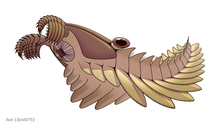| Peytoia Temporal range:
| |
|---|---|

| |
| Fossil specimen of Peytoia nathorsti | |

| |
| Reconstruction of P. nathorsti | |
| Scientific classification | |
| Domain: | Eukaryota |
| Kingdom: | Animalia |
| Phylum: | Arthropoda |
| Order: | †Radiodonta |
| Family: | †Hurdiidae |
| Genus: | †Peytoia Walcott, 1911 |
| Type species | |
| †Peytoia nathorsti Walcott, 1911
| |
| Species | |
| |
| Synonyms | |
| |
Peytoia is a genus of hurdiid radiodont, an early diverging order of stem-group arthropods, that lived in the Cambrian period, containing two species, Peytoia nathorsti from the Miaolingian of Canada and Peytoia infercambriensis from Poland, dating to Cambrian Stage 3.[1] Its two frontal appendages had long bristle-like spines, it had no fan tail, and its short stalked eyes were behind its large head.
108 specimens of Peytoia are known from the Greater Phyllopod bed, where they comprise 0.21% of the community.[2]
Peytoia nathorsti and its junior synonym Laggania cambria played a major role in the discovery of the radiodont body plan. Initially interpreted as a jellyfish and a sea cucumber respectively, they were eventually shown to be the mouthparts and body of a single animal, which bore Anomalocaris-like appendages.
Peytoia infercambriensis is the geologically oldest known radiodont species.[1]
- ^ a b Cite error: The named reference
daley2015was invoked but never defined (see the help page). - ^ Caron, Jean-Bernard; Jackson, Donald A. (October 2006). "Taphonomy of the Greater Phyllopod Bed community, Burgess Shale". PALAIOS. 21 (5): 451–65. Bibcode:2006Palai..21..451C. doi:10.2110/palo.2003.P05-070R. JSTOR 20173022. S2CID 53646959.